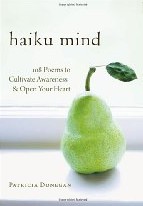The second attribute of the classical
haiku:
Juxtaposition of images.
In one line you have your 'Season Word(s)'.
Put your second image in the other two lines.
|
Consider the energy between your two images.
Try to make them different enough to have some energy between them, a gap that electricity can jump across.
Traditionally Japanese has no punctuation. Often a Japanese haiku connects its images by
a kireji (cutting word).
That's similar to the way in English we say, "dot dot dot"
or "quote".
A haiku in Japanese is written in a single vertical line
of three phrases, with a standard rhythm that provides pauses
after the first and second phrase.
In English, translators have inserted line breaks to signify this pause.
The line break can be enough; or use an em-dash or ellipsis.



 Higginson, William J. (1996a).
The Haiku Seasons: Poetry of the Natural World. Tokyo: Kodansa International. [History of haiku and linked verse.]
Higginson, William J. (1996a).
The Haiku Seasons: Poetry of the Natural World. Tokyo: Kodansa International. [History of haiku and linked verse.]



